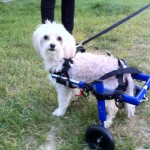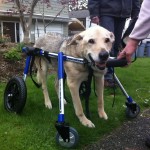 Trupanion offers coverage for orthotics, prosthetics, and carts under core coverage. These assistive devices help disabled pets live a happy, normal life.
Trupanion offers coverage for orthotics, prosthetics, and carts under core coverage. These assistive devices help disabled pets live a happy, normal life.
Pet owners are always looking for ways to provide the best quality of care and quality of life for their pets. When a crisis strikes, resulting in a disabled pet, mobility devices are a phenomenal option to keep that pet living a happy, healthy life. The cost of these devices can sometimes be outside a family’s budget, but Trupanion policyholders have the opportunity to move forward with this treatment option at 90% coverage.
Mobility devices are covered under three categories: orthotics, prosthetics, and carts.
- Orthotics are external support structures for a pet’s leg that help reduce pain and maintain comfort. They can be used long-term or for support during the healing process.
- Prosthetics are used to replace a missing leg or portion of a leg that has been amputated due to a traumatic accident or illness. The device allows the pet to maintain the same level of activity as a pet with all four legs.
- Carts, often called ‘pet wheelchairs’, are frames in which a pet is placed that replace back-end mobility. Carts are designed to provide support and easy maneuverability for an immobile pet. There are even Quad Carts available for animals who have limited front-end movement.

These assistive devices aid in the well-being of the pet by correcting or accommodating the pet’s leg, including stabilizing a neurologically deficient limb, providing support for a weak joint, or preventing the shortening of muscles.
A pet can become disabled due to trauma, illness, or old age. Mobility devices can sometimes replace a more traumatic treatment, such as amputation, so it’s important to have all the options available to make the best decision for the pet.
What kinds of mobility devices are covered?
- Orthotics: These devices are external support structures for a pet’s leg that help reduce pain and maintain comfort. They can be used long-term or for support during the healing process.
- Prosthetics: These devices are used to replace a missing leg or portion of a leg that has been amputated due to a traumatic accident or illness. The device allows the pet to maintain the same level of activity as a pet with all four legs.
- Carts: Often called ‘pet wheelchairs’, these devices are frames in which a pet is placed that replace back-end mobility. Carts are designed to provide support and easy maneuverability for an immobile pet. Typically, a pet must have normal front leg strength in order to power the cart.
Do you cover cosmetic prosthetics?
No, we do not cover cosmetic prosthetics, such as neuticles. We only provide coverage for medically necessary prosthetics used for treatment of a covered accident or illness.
Is there an additional cost for this coverage?
No, coverage for mobility devices falls under our core policy, meaning there is no additional cost or rider to purchase in order to receive this coverage.
What health conditions are most commonly treated with mobility devices?
Mobility devices are used to aid in a variety of different health conditions, including but not limited to:
- Neurologically deficient limbs
- Paralysis
- Weak joints
- Shortening of muscles
- Amputation of limbs
- Recovery from surgery
- Elbow dysplasia
- Osteochondrosis
- Arthritis
Why haven’t mobility devices always been covered?
We listen to our customers and meet policyholder needs better than anyone else in the industry. It was only recently that mobility devices became a veterinary standard of care, and once we understood that, we immediately put plans into motion to include this treatment option in our core policy.
Will you cover mobility devices bought directly from the manufacturer or do I have to buy it from my veterinarian?
While we generally require pet owners to purchase products though their veterinarian, in this case, many veterinarians don’t normally stock these devices so may refer clients elsewhere to purchase them. Thus, while the device doesn’t have to be purchased from your veterinarian, it must be medically advised by your veterinarian as part of a treatment plan for an injury or illness that is covered.

